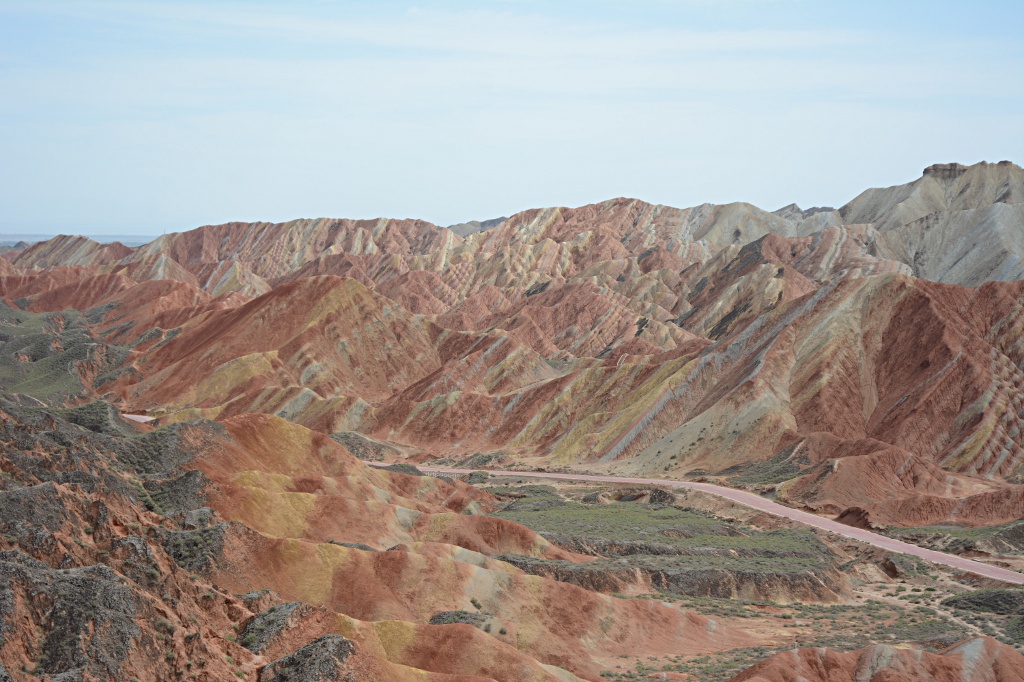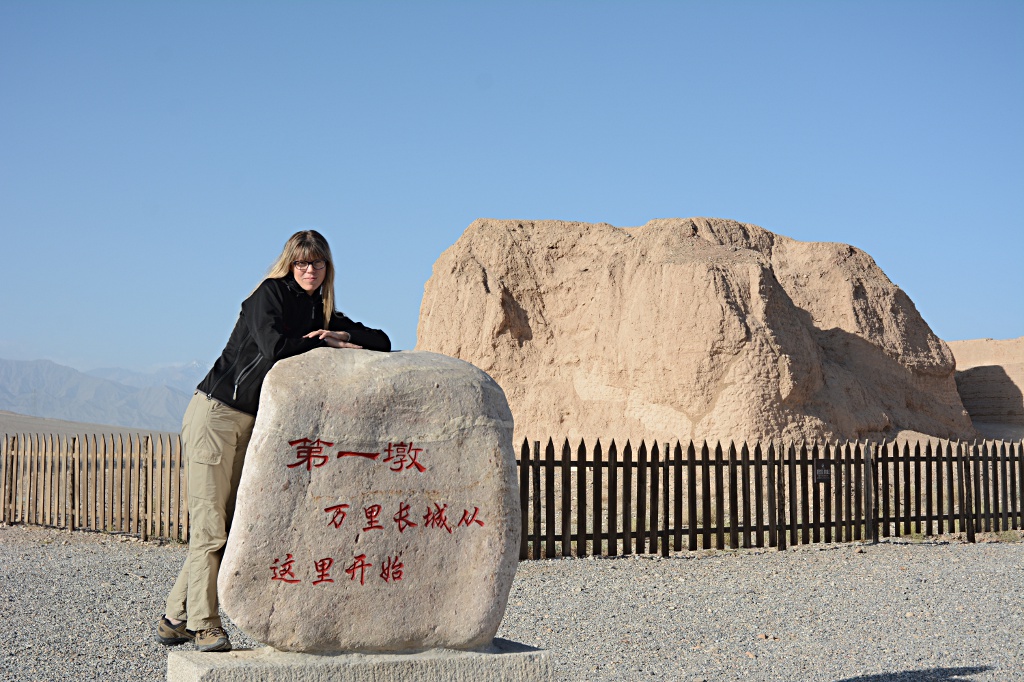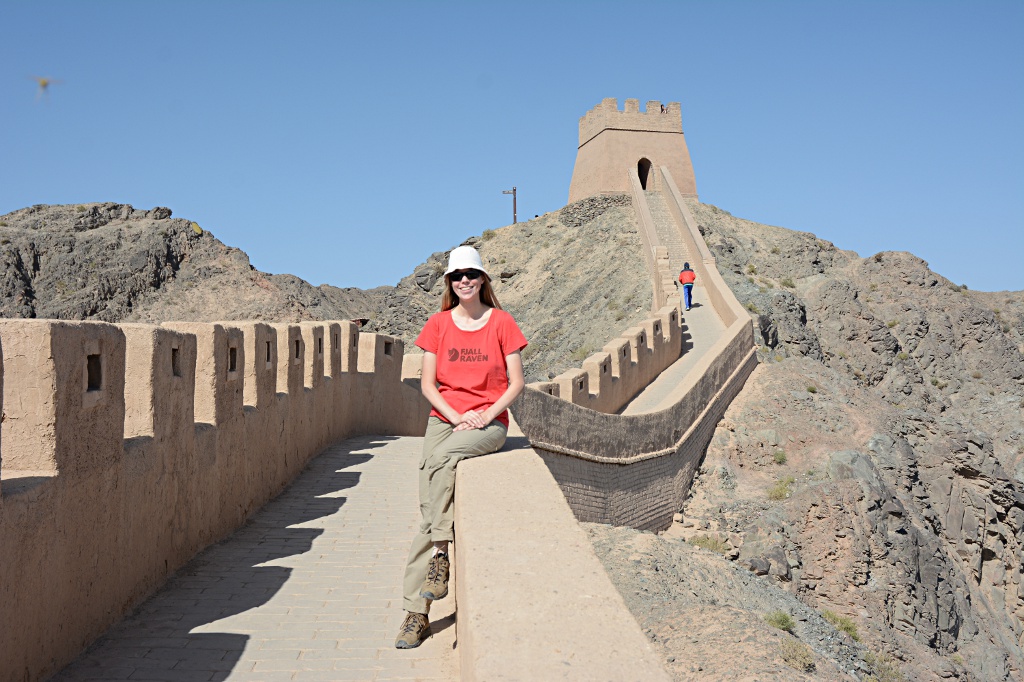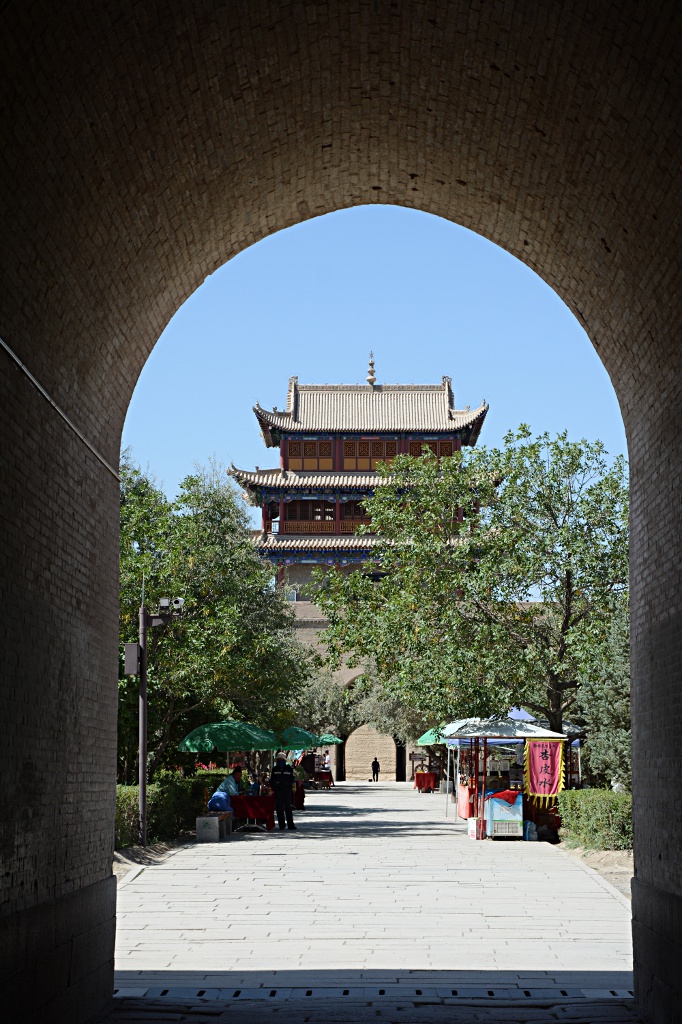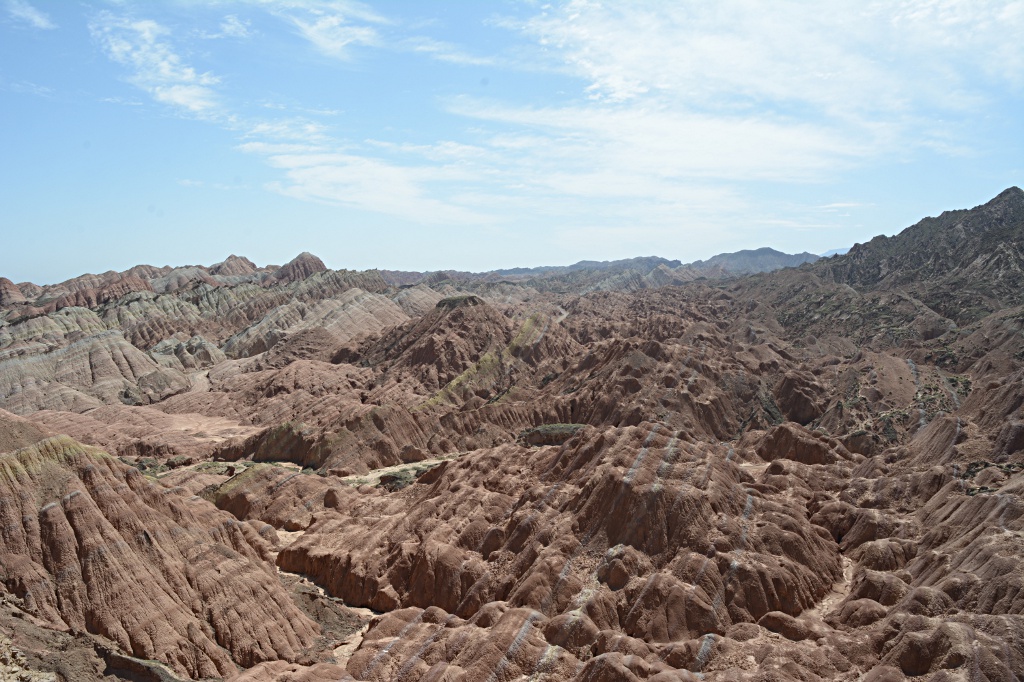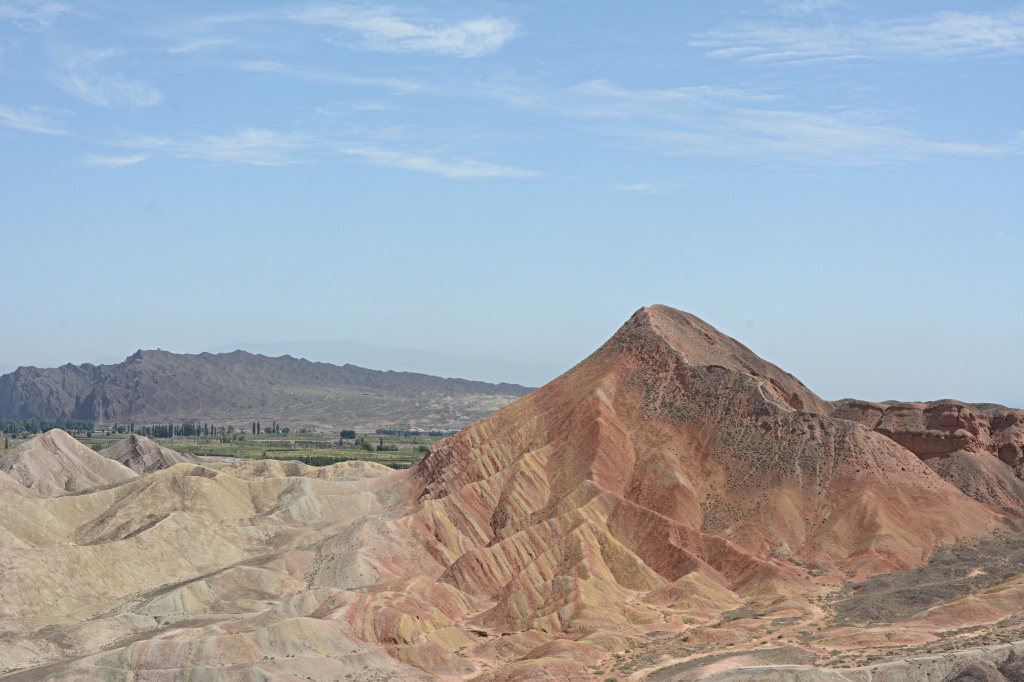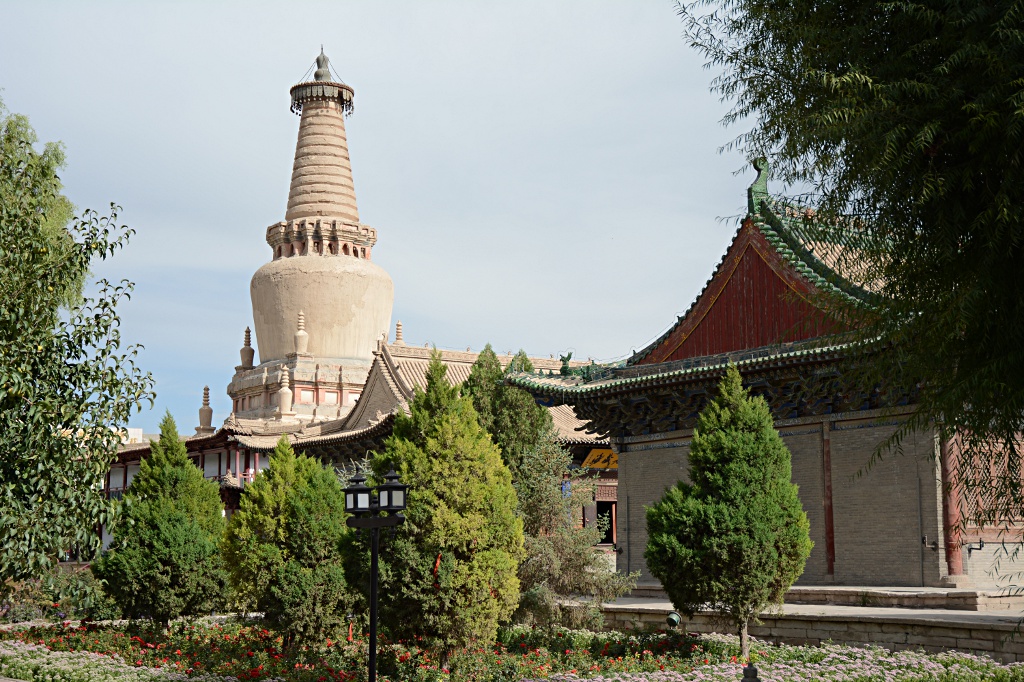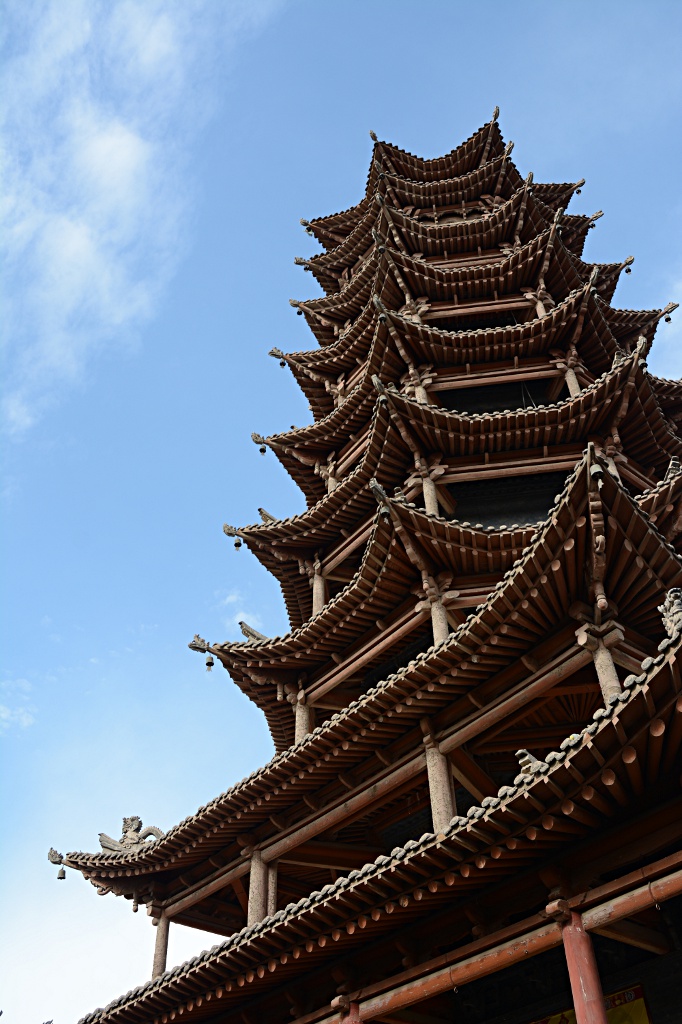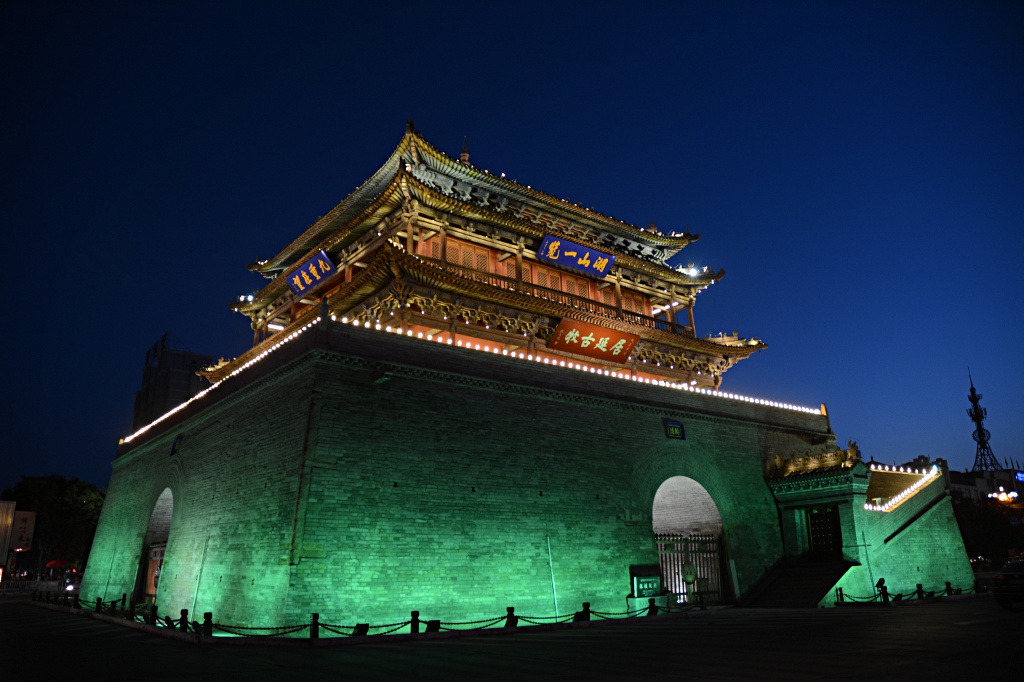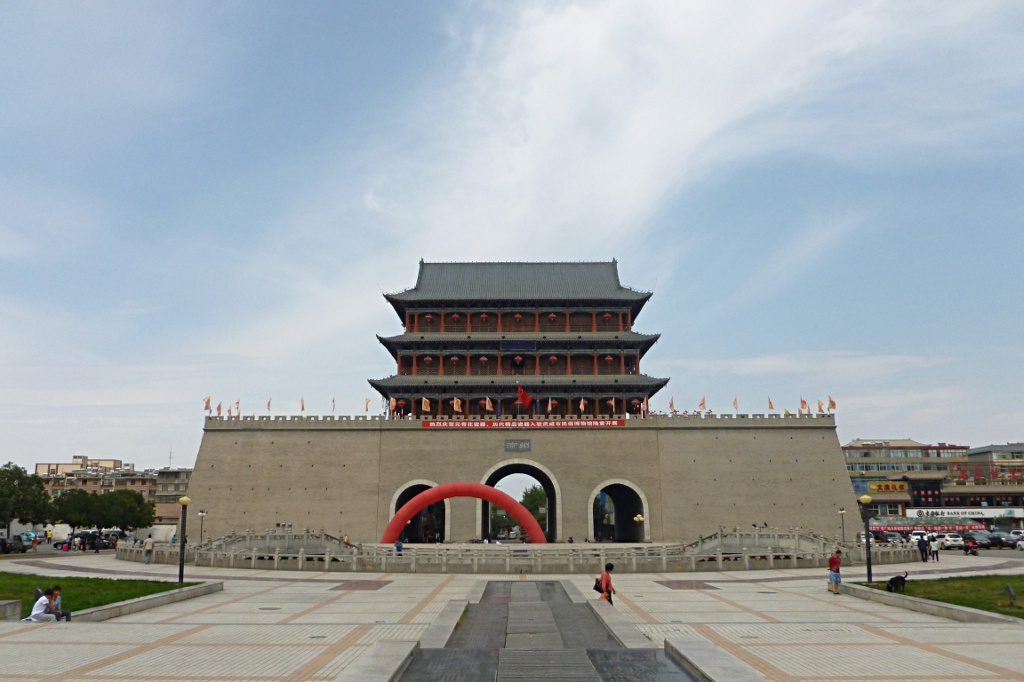After a little more than two days in Dunhuang we had to re-pack our backpacks for the first time. Luckily we had decided to travel light, such that we had to stow away much less tan 10kg each (plus the photo and electronics equipment). At 8:40am the bus left for Jiayuguan at the Western end of the Hexi corridor, which would be giving our trip the direction for the next few days.
The visit of Dunhuang as well as the following journey from there through the Hexi corridor impressively demonstrated how all cities in this area are oases in the desert or desert-like area between the Gobi desert to the north and the Tibetan plateau to the south. While the countryside between the cities is almost devoid of any living creature, at least at first sight, suddenly everything changes as soon as the landscape color change to green and well-kept fields and buildings start to appear. Our city hopping along the Hexi corridor pretty much resembles at a much faster pace of what people did more than 500 years ago during the high-time of the Silk Road. The fertile oasis and the snow-capped mountains in the background could almost be set somewhere in central Europe.
Our first stop was a déjà vu experience for me, had I alread visit the Western end of the Ming Great Wall in Jiayuguan almost three years ago on my journey to Beijing. We were dropped off by the bus right off the freeway, such that we had to catch a taxi to the city center. Near the bus station, we soon found a place to stay for the following night. Since it was already 2pm, we decided to spend the rest of the day in the city and tackle the tourist attractions the next day. We took a mental note of the market and the connected food-court for later.
Coming back to said food-court the next morning, we enjoyed a delicious breakfast and some fun times with one of the locals who had breakfast at the same table. Finding a taxi driver who was willing to take us to the three typical sights around Jiayuguan proved to be simple, finding one asking for a reasonable price took three tries. Our first stop was the first beacon platform of the Great Wall, indicating the Southern end of this little stretch of the Great Wall. While we could be driven directly to the tower three years ago, we had to change transport to a small electric bus to drive us from the gate to the heap of rock and dirt. Of course there was some extra cost involved with the short drive… More impressive than the beacon platform is the gorge which is opening up just behind it. Since a shaky suspension bridge connects the two sides of the gorge, we had the opportunity to see the whole area from a different perspective. However that did not improve the lifeless impression the entertainment and shop area made. We assumed that there had probably been much more activity a few says earlier while the Chinese children were stil on summer vacation. We thus enjoyed the peace and quite and the beatiful sight of the snow mountains in the background.
The second stop on our sight-seeing tour happened to be the overhanging Great Wall, the northern end of the defense system at Jiayuguan. The short stretch of wall leading from the beacon tower in the south to the overhanging wall in the north kept enemies from the west at bay, protecting the pass at Jiayuguan. It was interesting to observe that the plastic caravan, which had already been there when I last visited, got some company from a second caravan made of stone. Additionally a new small skiing area had been built just outside the overhanging Great Wall tourist area.
Finally our taxi driver dropped us off at the fort of Jiayuguan. The massive fort with its 17m thick walls still seems to be impenetrable today. A wallet big enough however helps the tourist easily to conquer to fort. We checked it out from bottom to top and from front to back, before we made our way to the very insightful Great Wall museum. The museum not only helped us understand the geographical situation of Jiayuguan and the Great Wall in general, but also taught us about the challenges faced in supplying the large number of soldiers along the Great Wall. Lenka and I can now proudly claim that we saw the Great Wall from east, the Old Dragon Head in Shanhaiguan, to the west, the Ming dynasty end in Jiayuguan and the Han dynasty end at the Jadegatepass. No need to mention that there are thousands of kilometers of wall in between which we have not seen.
After our sightseeing rally, we enjoyed a quick lunch near the bus station before boardin the bus through the source of alcohol (é…´æ³o/oo, Jiuquan) to Zhangye in approximately the middle of the Hexi corridor. Around 8pm we were already lucky asking for room availability in the fourth hotel we entered. Apparently all the others did not have a license to accomodate foreigners. Good for us that all the hotels lay near the bus station and not far from each other. After a quick, but mandatory round of haggling, we checked out the food scene in the historic Mingqingjie. We successfully conquered a small hotpot near the Marco Polo statue, who apparently spent more than a year in Zhangye and who’s fault it probably is, that the road has a display of mock Venetian architecture.
We didn’t plan too much for the one full day we had in Zhangye, such that we could enjoy our pillows a little bit longer in the morning. Just before 10am we were back at the west bus station for a bus ride to the Danxia landforms about 40km south of the city. Since I had seen similar pictures of the place on different web-sites, I was worried that they all were talking about a single colorful rock. My fear was unfounded though, since even before we entered the geopark we already got a taste of colorful rocks all around.
Unfortunately we didn’t learn a whole lot about the how and why, but we understood that the different layers used to be different layers on the ocean ground with the red color being red sandstone. The amazingly strong colors range from red to brown to green and ocker. Buses shuttle the eager tourists from view point to view point and with a few extra steps on ones own, one gets the feeling to have landed in a fairy tale’s landscape. We didn’t know which direction to look since colorful rocks were all around us with a multitude of different patterns and shapes.
Once we had ourselves back under control, we headed back to the exit, where a bus back to Zhangye was already waiting for us. About an hours later we were back in the city where a taxi quickly brought us to the largest, wooden, indoor, reclining Buddha in China. Besides us, there were only two tour groups in the whole temple complex, such that we could enjoy the Buddha and the surrounding buildings and exhibitions.
On the way to dinner we visited the wooden pagoda as well as the park north of Qingmingjie. The pagoda is located on a huge square and standing a bit lost in one corner. However it does have its own charms and is worth dropping by.
Back at the hotel we asked the staff about buses to Wuwei. We were happy to learn that there were buses departing from the west bus station, right around the corner from our hotel. Since noodles are the main staple in the Hexi corridor (Dunhuang and Jiayuguan still featured rice porridge for breakfast) we opted to buy some raw materials to compose our breakfast ourselves. Since the bus was already ready to leave, we had breakfast on the bus. After a multitude of stops on Zhangye and the collection of boxes and passengers, we finally drove along hundreds of kilometer of Great Wall to Wuwei. It was amazing to see such long stretches of Great Wall and gave a very good idea of what it means to be looking at a few thousand of kilometers of wall across almost the whole country.
Once in Wuwei a nice local helped us to find the reconstructed south gate of the former city wall, near which we found a place to stay for the night. With the help of the city map lent to us by the hotel staff, we decided on a plan for the afternoon.
Our city tour would take us from the south gate to the Confucius Temple, the Big Cloud Temple, the central square, the Kumarajiva pagoda to the flying horse at the Leitai Temple.
While the Confucius Temple was under reconstruction and the Big Cloud Temple rather limited, the big temple complex around the Kumarajiva pagoda is brand new, but quite colorful and impressive.
The main attraction of the city however is the flying horse, which was discovered in a grave below the Leitai Temple in 1969. The small flying horse made of copper, standing on a flying bird with one hoof, along with the remaining copper warriors (similar to, but much smaller than the terracotta army in Xi’an) were rebuilt in a larger scale on the huge square in front of the temple.
Looking for a delicious dinner, we happend to cross the market. One of the salesmen saw us foreigners and mentioned the Americans to his friends. He was quite surprise to be told that we were not Americans but from Slovakia and Switzerland. Also the salespeople who sold us snacks and fruits were quite irritated by the fact that foreigners were showing up at their stalls. Wuwei apparently does not encounter a lot of foreigners, seeing some who know a few words of Chinese completely throws the locals off.
Finally we feasted on a delicious fish near our hotel and only were able to roll back to our hotel, we were that stuffed. Fortunately we were still able to produce a fresh and still work blog post for all the readers…
But where to tomorrow?

